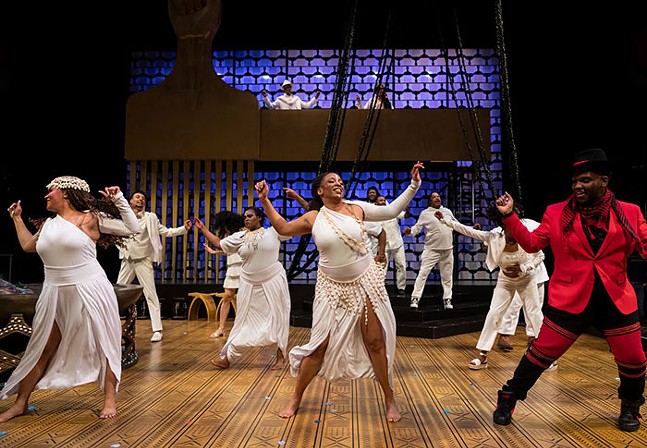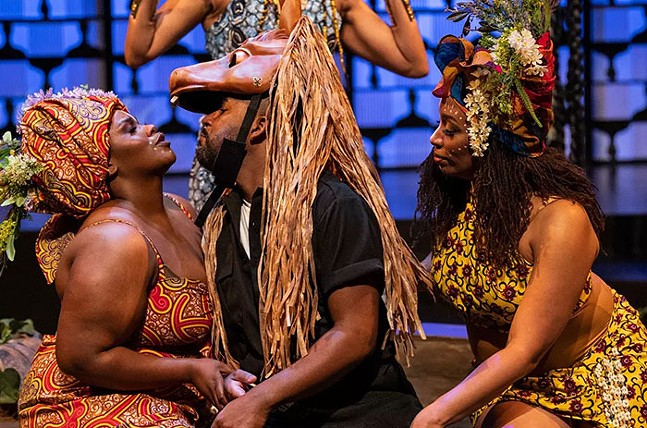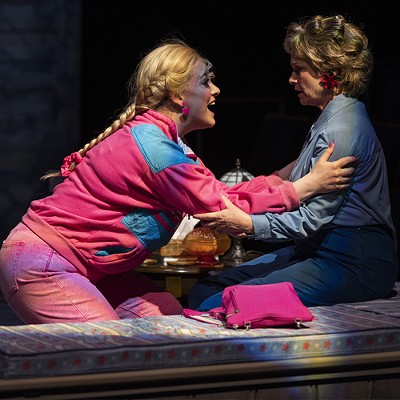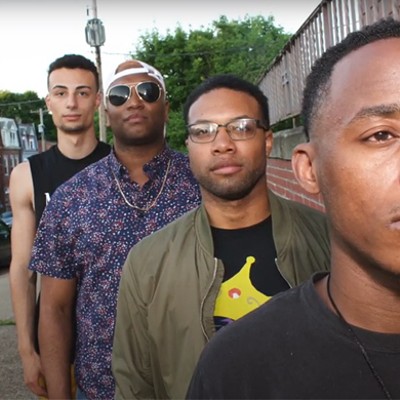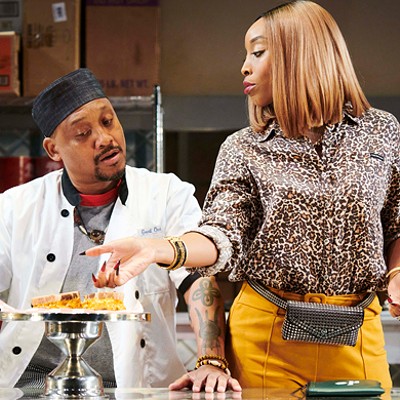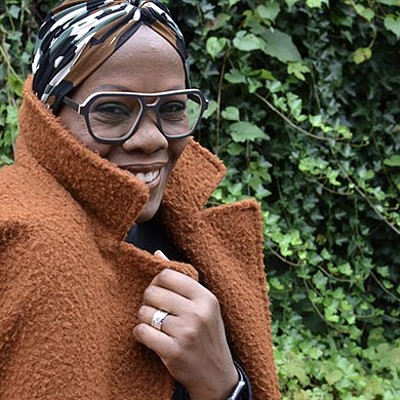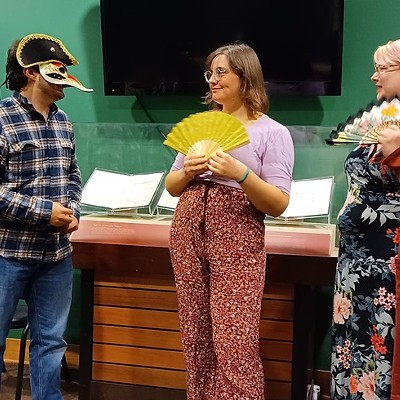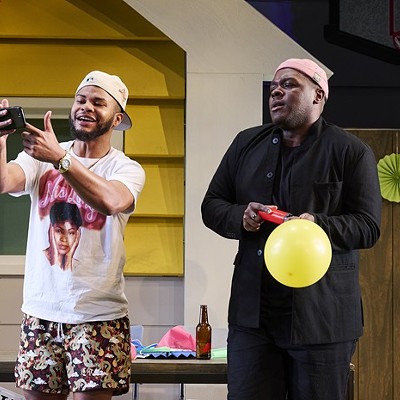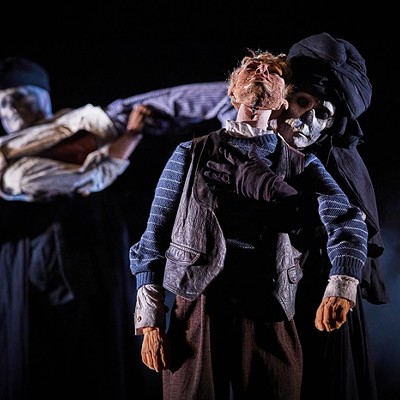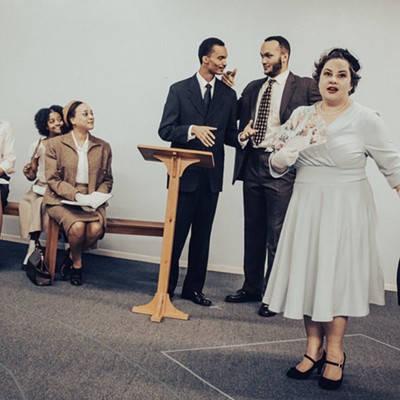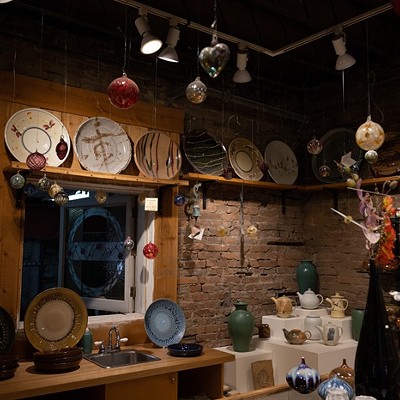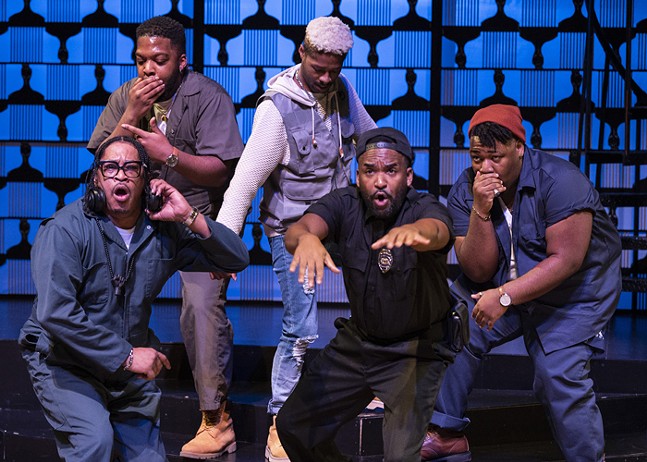
You don’t have to be a Shakespeare buff to enjoy Pittsburgh Public Theater’s production of A Midsummer Night’s Dream in Harlem.
The joyful and life-affirming energy of director Justin Emeka’s take on the classic comedy rolls off the O’Reilly Theater stage in waves, washing away even the stodgiest preconceptions of what Shakespeare is “supposed” to be.
Emeka, PPT’s immensely talented resident director, brings the magic and artistry of the Harlem Renaissance to ancient Athens, setting the classic comedy in a dreamy “African melting pot of the New World,” rendering Shakespeare’s language through a lens of African and contemporary Black culture. His playful and inventive approach makes the play both timeless and rooted in the here and now.
Although this may be a novel setting for this particular play (Emeka previously explored this concept in New York City), Emeka notes that there’s nothing new about Black people performing Shakespeare or Shakespearean productions that transcend the boundaries of historical accuracy.
"There is a long, long history of Black people performing Shakespeare that dates back hundreds of years, and yet, still many question how to do so effectively and what it means to his plays,” Emeka says in a press release. “Ultimately, we are Black artists who are unapologetically claiming our place as Black people inside Shakespeare’s imaginary worlds.”
In his Director’s Note, Emeka further explains that Shakespeare’s original productions often blended ancient and mythical settings with the culture of 1500s England, emphasizing the enduring nature of the play’s themes while also giving his audiences the ability to see themselves in the characters.
Midsummer presents three chaotic, intersecting plots, populated in this production by excellently-cast performers energetically aligned to produce sharp comedic timing.
In Athens, Duke Theseus (Keith Lee Grant) prepares for his wedding to Hippolyta (Portia), who he either captured as a prisoner of war or wooed away from the island of the Amazons, depending on who you ask. Before he can focus on his own nuptials, however, he is called in to resolve the tensions between four young lovers enmeshed in two overlapping love triangles.
Emeka’s queer twist on the play’s four lovers opens with Hermia (Saige Smith) standing in proud defiance of her betrothal to Demetrius (Brenden Peifer), a handsome and vapid playboy. Instead, she proclaims to her father (E. Mani Cadet) and Theseus her love for Lysandra (Amara Granderson). (Traditionally, Lysandra would have been Lysander and played by a man.)
Hermia’s best friend, Helena (June Alvilda Almonte), loves Demetrius, who seemed into her until he fell for Hermia. Helena desperately tries to win back his affection as Hermia’s father announces that if Hermia refuses to marry Demetrius, according to Athenian law, he will execute her. In response, Hermia and Lysandra steal away to the forest to be married outside of Athenian jurisdiction, tailed by jealous Demetrius and Helena.
In the forest outside the city, Grant and Portia embody the also soon-to-be-wed fairy king and queen Oberon and Titania, respectively. Before they wed, Oberon seeks to get rid of Titania’s attachment to the African Boy, played by multi-talented musician Akinlana Lowman, who accompanies his fellow performers on the djembe and berimbau. Three fairies (Chrisala M. Brown and Calina Womack, joined in my performance by understudy Hope M. Anthony) attend to Titania and frame the play’s scenes with rhythm, song, and dance.
Once the lovers arrive in the forest, they are spotted by Oberon and his sidekick Puck (Jaris Owens), who engage in some magical meddling that throws the quartet’s relational dynamics into total disarray. In an attempt to reconcile the group’s conflicting desires, Puck uses a magic love plant to redirect Demetrius’ ardor from Hermia to Helena, which seems like a good plan until Puck mistakes Lysandra for Demetrius.
All four young actors excel in the sharp contrasts and physical comedy that drive their storyline, bouncing between the extremes of love and hate, desire and disgust. Granderson's bold, charismatic, and steady Lysandra makes an excellent foil to Peifer’s clownish machismo as they fall over each other to woo Almonte’s earnest and wary Helena. Smith confidently luxuriates in Lysandra’s certain love until she snaps into an understanding of her new reality with fierce rage.
The third plotline involves a crew of amateur actors preparing a play for the Duke’s wedding. Coming to play rehearsal straight from work in their security uniforms and Dickie’s coveralls, this production’s likable crew of Rude Mechanicals are beautiful and exuberant in their incompetence, knit together by genuine love and care for each other.
Led by Quince, a sweet but firm gym teacher type also played by E. Mani Cadet, Snug (Brian Starks), Flute (Harry J. Hawkins IV), Snout (Marshall Weir Mabry IV), Starveling (Richard McBride), and Bottom (Andre G. Brown) make a hilarious attempt at staging a parable of ill-fated lovers Pyramus and Thisbe until they, too, wander into the forest and become targets of Oberon and Puck's mischief.
The performers’ range and brilliance are reflected in the play’s brightly colored visual landscape.
The costumes, designed by local fashion designer/curator Demeatria Boccella, mix 1920s-inspired finery for Theseus and Hippolyta, fresh contemporary outfits for the lovers and Mechanicals, and colorful African and Afro-Carribbean-inspired dresses and tunics for the magical inhabitants of the forest.
The set design by Anka Lupes orients the action around a golden balcony that appears cantilevered by a giant Afro pick with a Black power fist for a handle, in front of a backdrop patterned with smaller picks. A large, carved wooden head with vine-laced braids presides majestically over the magical forest. Sound/projections by Zach Moore and lights by Jared Gooding help move the story among its several settings and lend a psychedelic sheen to the play’s fairy magic.
The gorgeous combination of joyful Black excellence with Shakespearean plot and prose is not to be missed.
A Midsummer Night’s Dream in Harlem. Continues through Sun., Feb. 19. O'Reilly Theater. 621 Penn Ave., Downtown. $32-85. ppt.org

